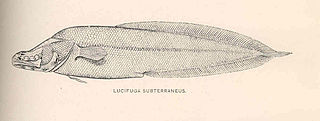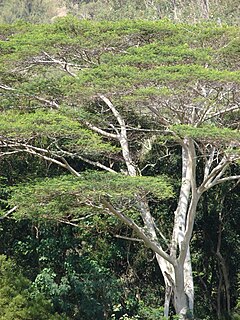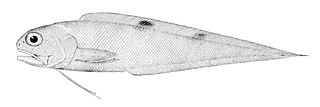Neopseustidae is a small family of day and night-flying "archaic bell moths" in the order Lepidoptera. They are classified into their own superfamily Neopseustoidea and infraorder Neopseustina. Four genera are known. These primitive moths are restricted to South America and South east Asia and their biology is unknown. Nematocentropus appears to be the most primitive genus occurring in Assam, Myanmar and Sichuan, China, three species of Neopseustis are distributed from Assam to Taiwan, whilst Synempora andesae and three species of Apoplania occur in southern South America. The morphology of the antennae and the proboscis has been studied in detail.

The viviparous brotulas form a family, the Bythitidae, of ophidiiform fishes. They are known as viviparous brotulas as they generally bear live young, although there are indications that some species do not. They are generally infrequently seen, somewhat tadpole-like in overall shape and mostly about 5–10 cm (2–4 in) in length, but some species grow far larger and may surpass 60 cm (2 ft).

Lucifuga is a genus of viviparous brotulas. Most of the species are native to caves and sinkholes in Cuba and the Bahamas; L. inopinata from deep water off the Galápagos Islands is the only exception. The four species rated by the IUCN are all considered vulnerable. The largest species in the genus reaches about 15 cm (5.9 in) in length.
Parasaccogaster melanomycter is a species of viviparous brotula endemic to Colombia.

Saccogaster is a genus of viviparous brotulas. They are found in the western Atlantic and Indo-Pacific.

Falcataria is a genus of flowering plants in the legume family, Fabaceae. It belongs to the monophyletic Mimosoid clade in the subfamily Caesalpinioideae. The genus has three species previously classified in the Falcataria section of the genus Paraserianthes by I.C. Neilsen. The distribution of these closely related species within the genus Falcataria links the wet tropics of north-east Australia to New Guinea, the Moluccas, Bismarck Archipelago, and the Solomon Islands east of Wallace's line similar to other plant taxa from the region.

Paraserianthes is a genus of flowering plants in the legume family, Fabaceae. It belongs to the mimosoid clade of the subfamily Caesalpinioideae.
Palatobaena is an extinct genus of baenid turtle. It was first named by Gaffney in 1972 and the type species is Palatobaena bairdi. It based on a fragmentary skull from the Fort Union Formation of the Bighorn Basin of Wyoming. The two other species are P. gaffneyi and P. cohen which existed in Hell Creek Formation, North Dakota during the late Cretaceous period.
Bellottia is a genus of viviparous brotulas which is found in the subtropical waters of the North Atlantic, the Mediterranean Sea and the Indo-Pacific.
Bythites is a genus of viviparous brotulas found in the Atlantic Ocean.
Cataetyx is a genus of viviparous brotulas.
Grammonus is a genus of viviparous brotula.
Gunterichthys is a genus of viviparous brotula.
Onuxodon is an Indo-Pacific genus of pearlfishes from the family Carapidae. The generic name is derived from the Greek onyx meaning "claw" and odon meaning "tooth", referring to the sharp fang like teeth of Onuxodon parvibrachium. Species in this genus are distributed from South Africa to Hawaii. They live commensally with molluscs. The three currently recognized species are:
Luciobrotula is a genus of cusk-eels.

Neobythites is a genus of cusk-eels.

Sirembo is a genus of cusk-eels of the subfamily Neobythitinae, family Ophidiidae, which are found in the Indian and Pacific Oceans. The species in this genus have a rather robust body with the dorsal fin originating over vertebrae 1–5. The head and bod are completely covered in scales, they have large eyes which are almost equal in diameter to the length of snout, the pelvic fins have two rays which are joined together within an area of tough skin, They have a short spine on the operculum which does not extend to the posterior edge of the head. Their coloration is variable but almost all species have black spots or eyespots on the dorsal fin, sometimes both, while the middle part of the anal fin frequently has a black band. The body and/or head are marked with diagonal or horizontal dark stripes or horizontal rows of quite large dusky spots.
Spottobrotula is a genus of cusk-eels.
Grammonus waikiki, or the Waikiki viviparous brotula, is a species of viviparous brotula found in the Hawaiian Islands where it occurs at depths of around 3–18 metres (9.8–59.1 ft).

Bythitinae is a subfamily of viviparous brotulas, one of the two subfamilies in the family Bythitidae. This subfamily is characterised by having the dorsal, caudal and anal fins combined. They are mostly found in temperate to tropical seas, from reefs to the benthopelagic zone, but some species from the North Atlantic Ocean occur in into Arctic waters.






